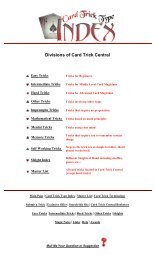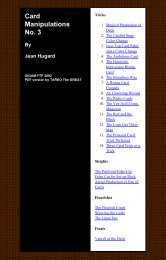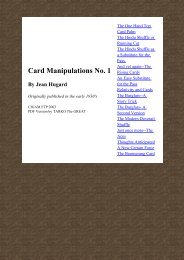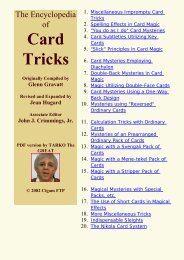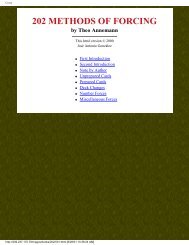Card Manipulations No. 4 By Jean Hugard - Umclidet
Card Manipulations No. 4 By Jean Hugard - Umclidet
Card Manipulations No. 4 By Jean Hugard - Umclidet
Create successful ePaper yourself
Turn your PDF publications into a flip-book with our unique Google optimized e-Paper software.
<strong>Card</strong> <strong>Manipulations</strong> <strong>No</strong>. 4<br />
<strong>Jean</strong> <strong>Hugard</strong><br />
Next | Previous | Contents<br />
Everywhere and <strong>No</strong>where<br />
This is one of the most effective card tricks ever devised.<br />
The reason that it is so seldom seen is probably because the<br />
explanations given in the textbooks are unnecessarily<br />
complicated and give the trick the appearance of being very<br />
difficult. The moves in the routine that follows have been<br />
arranged to simplify the procedure as much as possible.<br />
The only requirements area small stand or card easel or,<br />
failing that, three glasses, against which to stand cards for<br />
display, an ordinary deck of cards with two extra duplicate<br />
cards, two Tens of Spades for example. Any card can be<br />
used but the black suits are preferable if the feat is to be<br />
performed before a large audience since the spots stand out<br />
so much more plainly under artificial light. Let us suppose<br />
that Tens of Spades are used, place all three on top of the<br />
deck.<br />
Begin by shuffling the deck overhand in this mannerundercut<br />
about three-quarters of the deck, injog the first<br />
card and shuffle off. Ask a spectator to draw a card, insert<br />
the tip of the left little finger below the jogged card and,<br />
spreading the pack, force one of the three Tens. This is<br />
much easier and more natural than making the pass to bring<br />
the Tens to the middle. The shuffle, being quite genuine as<br />
far as the cards actually shuffled are concerned, tends to<br />
throw the spectator off his guard and renders the force<br />
easier. In any case there should be no difficulty in forcing<br />
one of the three Tens.<br />
As the spectator notes his card, close up the deck and insert<br />
the tip of the left little finger above the two remaining Tens.<br />
Hold the deck in right hand, fingers at the outer end, the<br />
thumb at the inner end, holding the break. As you ask the<br />
spectator to replace his card allow a few cards to drop from<br />
the bottom of the deck on to your left palm, then a few<br />
more, finally let drop. all the cards below the break and hold<br />
the left hand out to receive the chosen card which is thus<br />
returned on top of the other two Tens. Make the pass, or<br />
better, bring the Tens to the top by means of the Pass<br />
Substitute <strong>No</strong>. 1.<br />
It is necessary now to place the Tens so that one shall be<br />
next to the bottom card, one on top of the deck and the third<br />
one third from the top. To do this the simplest way, grasp<br />
the pack with the right hand as for an overhand shuffle,<br />
press firmly on the top and bottom cards with the fingers<br />
and thumb of the left hand and lift all the cards but these<br />
two with the right hand. The top card, the first Ten, will fall<br />
on the bottom card and you drop the cards from the right<br />
hand on top of them, thus placing the first Ten next to the<br />
bottom. Do this casually, while talking, then as if having<br />
changed your mind as to the manner of shuffling, split the<br />
deck in half and riffle shuffle. Let the two lowest cards in<br />
the left hand packet fall first, then execute a genuine riffle<br />
until the top cards of the packets are reached. Hold back the<br />
top card of the left hand packet and let it fall between the<br />
two top cards of the right hand packet, i.e. between the other<br />
two Tens. The three cards are now in the position required-one<br />
on the top, one third from the top and the last next to the<br />
bottom card.<br />
The usual patter runs to the effect that by means of a<br />
scientific system a card can be found in a shuffled deck in<br />
not more than three trials. "The most likely position," you<br />
say, "Is the top of the pack." Make a double lift and show<br />
the second card.<br />
"Is this ..... of ..... your card?"<br />
"<strong>No</strong>."<br />
"Then I'll put it here on the table out of the way." Turn the<br />
two cards down, as one, take off the top card, the first Ten<br />
of Spades, and put it face down on the table or easel, or<br />
stand it upright against one of the glasses.<br />
"The next likely position is on the bottom. Here is your<br />
card, the ..... of ..... " Say this confidently as if sure of its<br />
being right and hold the pack upright in the left hand, the<br />
bottom card facing the audience.<br />
"What? Wrong again? Then I must put this card with the<br />
other one." Drop the left hand and by means of the Glide<br />
draw out the second Ten of Spades and put it beside the<br />
first. <strong>No</strong>w shuffle overhand by first running one card, then<br />
drop about half the deck on it, injog one card and shuffle<br />
off. The last Ten being the next card below the jogged card,<br />
make a break at that point with the right thumb at the inner<br />
end of the deck, separate the next two cards, Ten of Spades<br />
and an indifferent card, from the rest and push them<br />
forward, as one card, till they protrude from the outer end of<br />
the deck for about an inch. Turn the pack upright and with<br />
the right hand, thumb at rear and fingers in front, pull the<br />
two cards up for about three-quarters of their length above<br />
the deck. Assert now with the utmost confidence that you<br />
have succeeded.<br />
"I have only one more chance and as my system has never<br />
failed yet this ..... of ..... simply must be your card. <strong>No</strong><br />
again? You are sure? Pardon me, but did any one else see<br />
the chosen card? Oh, excuse me. I don't doubt you far a<br />
moment, but it is such an extraordinary thing for the trick to<br />
fail I thought you might have made a mistake. This is not<br />
your card." The more bewildered and anxious you can<br />
appear to be, the better the final effect. Drop the left hand,<br />
push the lower of the two cards flush with the pack, draw<br />
out the upper card, a Ten of Spades, and put it with the other<br />
two on the table.<br />
"I must finish the trick somehow. You all say that not one of<br />
these cards (point to the easel or the glasses) is your card?<br />
Very well. May I ask you what was the card you chose? The<br />
Ten of Spades? Do you think it would be possible for me to<br />
make you see any one of these cards as the Ten of Spades?<br />
<strong>No</strong>? Let us try.<br />
Which one shall I take? The middle card?"<br />
Take that card and hold it with its back to the audience.<br />
"Of course it isn't really a Ten of Spades, but it will appear<br />
so to you."<br />
Wave your hands in pretended hypnotic passes, then turn<br />
the card face out.<br />
"You all see it as the Ten of Spades? Very well, I will<br />
replace it here."<br />
Make the bottom change in the swing towards the table and<br />
put the indifferent card down face inwards.<br />
"You are still skeptical? Let me prove that you are all under<br />
hypnotic influence. Of these two which would you like to<br />
see as the Ten of Spades? This one? Very well."<br />
Repeat the same business and again change the card for an<br />
indifferent one by the bottom change, placing this card<br />
down with the first.<br />
"One card only is left. You will see this also as a Ten of<br />
Spades."<br />
Show the card as before, but this time it must be changed by<br />
the top change. Show the card upright, holding it with<br />
fingers on top end, thumb on the lower. The left hand holds<br />
the deck close to the body about waist high, as you say: "Of<br />
course the card is not a Ten of Spades. The real Ten is here<br />
in the deck."<br />
Drop the right hand bringing the card on top of the deck and<br />
at the same moment push the top card of the deck over to<br />
the right.<br />
Release the Ten of Spades from the right hand and grip this<br />
top card in exactly the same way. A moment later the left<br />
thumb pulls the Ten squarely on to the pack and moves<br />
away, the right hand remaining stationary. Finally place the<br />
indifferent card with the other two.<br />
"Let me give you further proof. You see this top card?"<br />
Make the double lift and show an indifferent card. Name it<br />
and turn the two cards, as one, face down. Take off the top<br />
card, a Ten of Spades, and after more hypnotic passes turn<br />
its face to the spectators.<br />
"<strong>No</strong>w you see it as the Ten of Spades." Replace it on top.<br />
Wave your hands again.<br />
"<strong>No</strong>w look at the bottom card. It also is the Ten of Spades."<br />
Hold the pack upright and show the Ten on the bottom.<br />
Under cover of this surprise make the pass and hold a break<br />
with the right thumb between the two packets. Show the<br />
pack upright in the right hand, bottom card facing the<br />
audience, an indifferent card is now seen to be there.<br />
"It is all an optical illusion. The cards are not really Tens of<br />
Spades. They only appear so."<br />
Place the pack in the left hand and slip the tip of the left<br />
little finger into the break. Lift off the top card and show it<br />
is an indifferent card now.<br />
"But when I put you under the influence you can see the<br />
Ten of Spades only, look."<br />
Cut the pack at the break and hold the top portion upright, a<br />
Ten of Spades again faces the audience, Insert the tip of the<br />
left little finger under the top card of the lower packet, i.e.,<br />
the third Ten. Replace the top packet and make the pass,<br />
bringing the three Tens to the bottom. Riffle off the inner<br />
ends of these three cards and insert the tip of the left little<br />
finger between them and the rest of the cards, and hold the<br />
deck in position to execute the bottom palm. (Erdnase, p.<br />
86.)<br />
"I know exactly what you all suspect, that I have been trying<br />
to mislead you and that all the cards are Tens of Spades. I<br />
wouldn't do anything as barefaced as that for worlds. Look!<br />
This card is not a Ten."<br />
Palm the three Tens in the left hand and at once turn the first<br />
card on the table face out. "<strong>No</strong>r this," turn the next, "and this<br />
last one is not a Ten either" Turn it also.<br />
"You see there is not a single Ten of Spades in the deck."<br />
Spread the cards face up on the table with a flourish turning<br />
your right side to the audience as you do so and slipping the<br />
three palmed cards into your left trousers pocket at the same<br />
moment.<br />
"In fact knowing that card is an unlucky one for my trick, I<br />
put it in my pocket before I began. Here it is."<br />
Thrust your left hand into your pocket, bring out one of the<br />
three Tens and thrown it on the table.<br />
masterpiece.<br />
Smoothly executed and<br />
well acted the feat has an<br />
extraordinary effect. It is<br />
one of the few card tricks<br />
suitable for performance<br />
before the largest or the<br />
smallest audiences. Paul<br />
Rosini, the Philadelphia<br />
prestidigitateur, makes a<br />
feature of the trick and in<br />
his hands it is a<br />
A very good plan for displaying the three cards when<br />
performing the trick in a parlor, is to take a large thick book,<br />
stand it upright and insert the cards as shown in the<br />
illustration. This is another idea of Dr. Jack Daley's who<br />
also makes a specialty of the trick. In his hands it leaves<br />
nothing to be desired.<br />
2. Using a Short <strong>Card</strong><br />
The use of a short card makes the placing of the three cards<br />
in position very easy. Put the short card on top of the pack<br />
with the three special cards following. Undercut about half<br />
the deck and shuffle overhand. Break the deck at the short<br />
and force one of the three Tens, then square the deck<br />
openly, tapping all sides on the table.<br />
For the return of the card, break the deck above the short<br />
card so that the chosen card goes on top of it. There will<br />
now be two Tens below the short card and one above it.<br />
When you break the pack to riffle shuffle include the short<br />
card in the right hand packet and let at least two cards from<br />
this portion drop first then hold back the top card and let it<br />
fall between the two top cards of the left hand packet. The<br />
three cards are then in the required positions viz. one on top<br />
one third from the top and the last one second from the<br />
bottom.<br />
The routine then proceeds exactly as in <strong>No</strong>. 1.<br />
3. With a Borrowed Deck<br />
This routine is another example of the subtle principle of the<br />
addition to a borrowed deck of strange cards, the faces only<br />
of which are seen by the audience producing thereby an<br />
extraordinary effect. Take two cards from any deck of the<br />
same value and suit as the card you propose to use for the<br />
trick, say Tens of Spades. Apply diachylon to the backs,<br />
sufficient to make them adhere to another card when<br />
pressed against it. Put one of these in your right hand<br />
trousers pocket, back outwards, and the other in your lower<br />
left vest pocket, also back outward.<br />
Locate the Ten of Spades in the borrowed deck and force it<br />
on a spectator. Palm the top card in your right hand and, as<br />
you ask him to hold the card up for all to see it when you<br />
turn your back, place right hand into pocket and press the<br />
palmed card on the prepared one already there. Palm out the<br />
two cards as you turn away from the audience, place them<br />
on the top of the pack and square the two cards carefully.<br />
Take the second prepared Ten from your vest pocket, put it<br />
face down on the top of the pack and slip a card from the<br />
bottom on top of it. Again square the edges of the cards and<br />
press firmly on them. Be careful to keep your elbows<br />
pressed .to your sides while making these moves.<br />
With these manufactured duplicates of the chosen card, the<br />
routine proceeds as in <strong>No</strong>. 1, up to the point at which the<br />
three cards on the table are shown as Tens of Spades. Then<br />
it is necessary to make the bottom change with the single<br />
card only. When one of the double cards is chosen exhibit it<br />
to the audience, upright, right fingers on top end and thumb<br />
on lower end. In apparently transferring it to the table take it<br />
with the left hand thumb on the back and fingers on the face<br />
card. Fig. 27.<br />
Pull the upper card, the<br />
indifferent card, away<br />
from the right hand and' at<br />
the same time slide the<br />
lower card, the stranger<br />
Ten, into the right palm.<br />
Put the indifferent card<br />
down on the table and<br />
quietly pocket the palmed<br />
card. The second double<br />
card is treated in just the<br />
same way and the fact that the deck is not used in these<br />
apparent transformations greatly increases the effect at that<br />
stage of the trick.<br />
The feat may be concluded by showing the Ten at the<br />
bottom of the pack, then spreading the pack to show that<br />
there are no duplicates and finally turning over the three<br />
indifferent cards on the table. Or, after showing the Ten on<br />
the bottom, side slip it to the top and show it there, then pass<br />
it to the middle by the slip cut and again exhibit it. Finally<br />
palm the Ten and produce it from your pocket as having<br />
been placed there before the experiment began.<br />
The feat in this form when done in a parlor with cards that<br />
the spectators know you have never had an opportunity of<br />
handling before, is one of the most impressive that can<br />
possibly be performed with cards.<br />
4. With an Ordinary Deck Without<br />
Duplicates<br />
Several methods have been devised for doing the trick<br />
without the aid of duplicate cards, the following is, perhaps,<br />
the best. It has the advantage of dispensing with the force,<br />
since any card may be used for the effect, but mastery of the<br />
Mexican Turn Over is necessary for its presentation.<br />
From any deck allow free choice of a card, have it replaced,<br />
bring it to the top, palm it and offer the deck to be shuffled.<br />
The expert will use his own favorite methods to accomplish<br />
these results but the neophyte is advised to use Pass<br />
Substitute <strong>No</strong>. 1, and the One Hand Top Palm, <strong>Card</strong><br />
<strong>Manipulations</strong> <strong>No</strong>.1. Replace the palmed card on top (See:<br />
Replacing Palmed <strong>Card</strong>s.)<br />
Pattering about the trinity of affinity, the spectator, the<br />
performer and the card, giving three chances to find the<br />
card, place the deck in your right hand outside coat pocket.<br />
Take off the two top cards, as one, and bring them out with<br />
the indifferent card showing to the audience. On being told<br />
that card is not the chosen card, place the two cards, still as<br />
one, face down on the left palm.<br />
Bring out any other card as the second chance. This, too is<br />
wrong and you put it face down on the other two cards on<br />
your left hand. Repeat the same process for the third chance,<br />
putting the card on the others but immediately palming it off<br />
again as you square the packet prior to spreading the three<br />
remaining cards fanwise with their backs to the audience.<br />
(See Gambler's Palm.)<br />
Remove the pack from your pocket, adding the palmed card<br />
in so doing, and put it on the table, cut and complete the<br />
curt, thus burying the card secretly returned to it. Lay the<br />
three cards face down on the table and spread them apart,<br />
the chosen card being in the middle. Suppose the middle<br />
card is now selected by a spectator, pick up one of the<br />
others and with it turn over the middle card in just the same<br />
way as when doing the Mexican Turn Over but do not make<br />
the change.<br />
Turn the card in hand face up but hold it tilted away from<br />
the spectators so that its face is not visible to them, and with<br />
it turn the chosen card face down, this time making the<br />
change, leaving the chosen card face down in the right hand.<br />
Drop this card beside the third card and again allow a choice<br />
to be made. In the same way by means of the Mexican Turn<br />
Over each of these is shown to be the chosen card.<br />
Take up the card and with a gesture towards the deck, make<br />
the bottom change and throw the card face down beside the<br />
other two. Finish by showing the chosen card at the bottom,<br />
then bringing it to the top by the side slip, from there to the<br />
middle by a false cut or top slip, finally palming the card.<br />
Spread the deck face up on the table and turn the three cards<br />
face up. There is no such card amongst them. Produce the<br />
chosen card from your pocket as having been placed there<br />
before you began.<br />
Next | Previous | Contents



